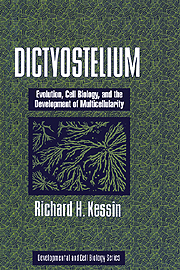Book contents
- Frontmatter
- Contents
- Preface
- 1 A Brief Introduction to Dictyostelium discoideum and its Relatives
- 2 A History of Research on Dictyostelium discoideum
- 3 The Evolutionary Biology of Dictyostelium
- 4 The Genome and Genetics
- 5 Membranes and Organelles of Dictyostelium
- 6 Cell Motility and the Cytoskeleton
- 7 The Transition from Growth to Development: From Starvation to Self-Sustaining cAMP Signal Relay
- 8 Chemotaxis and Aggregation
- 9 Differentiation and Adhesion in the Aggregate
- 10 The Behavior of Cells in the Slug
- 11 Culmination
- 12 Formation and Germination of Spores
- 13 Resources
- References
- Index
- Plate section
1 - A Brief Introduction to Dictyostelium discoideum and its Relatives
Published online by Cambridge University Press: 07 October 2009
- Frontmatter
- Contents
- Preface
- 1 A Brief Introduction to Dictyostelium discoideum and its Relatives
- 2 A History of Research on Dictyostelium discoideum
- 3 The Evolutionary Biology of Dictyostelium
- 4 The Genome and Genetics
- 5 Membranes and Organelles of Dictyostelium
- 6 Cell Motility and the Cytoskeleton
- 7 The Transition from Growth to Development: From Starvation to Self-Sustaining cAMP Signal Relay
- 8 Chemotaxis and Aggregation
- 9 Differentiation and Adhesion in the Aggregate
- 10 The Behavior of Cells in the Slug
- 11 Culmination
- 12 Formation and Germination of Spores
- 13 Resources
- References
- Index
- Plate section
Summary
Dictyostelium discoideum is the most studied species of the social amoebae, which are also known as the cellular slime molds. All of these organisms live in the soil and feed on bacteria, living a solitary life until the bacteria are consumed. The onset of starvation forces a major revision in the life cycle, and the amoebae respond by collecting into aggregates which transform into an organism that undergoes cell differentiation and morphogenesis. The result is a fruiting body consisting of a ball of resistant spores suspended on a stalk. D. discoideum and similar species have evolved strategies to survive in the harsh environment of the soil. A close examination of these strategies raises questions at all levels of biology: How do the amoebae sense starvation and other stresses, and how do they respond? How do they communicate with each other and how do they move? What mechanisms of signal transduction do they use, and how do those resemble the mechanisms of more complex organisms? How did the extraordinary cooperativity of development evolve? Rather than forcing the reader who has no experience with these organisms into details immediately, this chapter will provide a short glossary of terms and an overview of development, first in D. discoideum, and then in a few related species.
The developmental cycle begins when the amoebae consume all of their prey. If they do nothing to protect themselves, they will die from starvation.
- Type
- Chapter
- Information
- DictyosteliumEvolution, Cell Biology, and the Development of Multicellularity, pp. 1 - 8Publisher: Cambridge University PressPrint publication year: 2001
- 1
- Cited by



